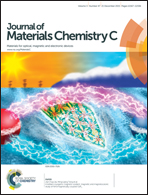Fast synthesis of red Li3BaSrLn3(WO4)8:Eu3+ phosphors for white LEDs under near-UV excitation by a microwave-assisted solid state reaction method and photoluminescence studies
Abstract
Red Li3BaSrLa3(WO4)8:Eu3+ phosphors have been successfully synthesized by a rapid microwave-assisted solid state method. The sintering time for the optimal phosphor can be limited to only 10 minutes at 900 °C. Upon near-ultra-violet (NUV) excitation, strong red emission can be found in 90% Eu3+ doped tungstate compounds. This phosphor exhibits impressive thermal stability, and the purity of red emission Li3BaSrLa3(WO4)8:Eu3+ in high Eu3+ doping concentrations can achieve the coordinate values (x = 0.670, y = 0.330), indicating high red color purity. The corresponding quantum yield (QY) is measured (28.36 ± 0.09%). Photoluminescence and kinetic studies showed no obvious effects due to the concentration quenching effect, cross relaxation and non-radiative energy transfer. Li3BaSrLa3(WO4)8:Eu3+ can be synthesized using a simple and quick method and the comprehensive photophysical studies of the novel phosphor (Li3BaSrLa3(WO4)8:Eu3+) have been done and the potential as a practical phosphor for NUV-excited white LEDs (WLEDs) has been shown.



 Please wait while we load your content...
Please wait while we load your content...